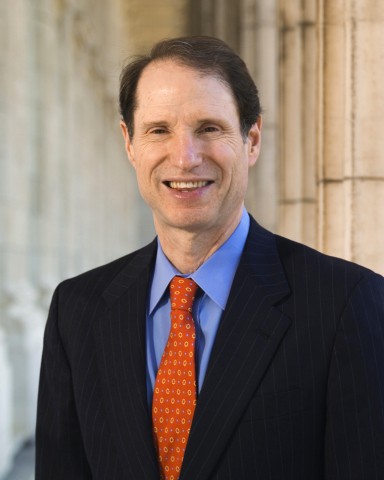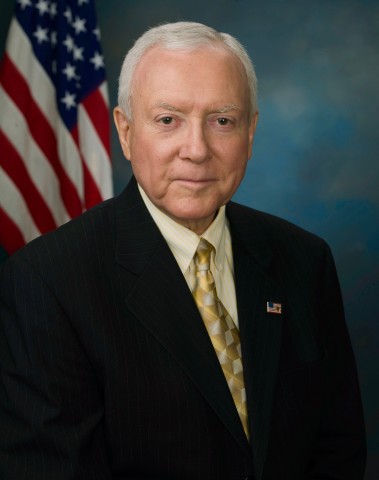Inside Game: How Foster Care Was Changed Forever

Democratic Senator Ron Wyden of Oregon was furious and heartbroken.
Nearly three years after Wyden launched an overhaul of the country’s foster care system, the bipartisan legislation he had championed was dying. At 2:47 a.m. on a December morning in 2016, Wyden, the ranking member of the Senate Finance Committee, stepped into the well of the Senate to plead with his colleagues to pass the sweeping Family First Prevention Services Act that he had crafted alongside the committee’s chairman Orrin Hatch, a Utah Republican. The measure would free up federal funds to help families at risk of losing their children to foster care.
For decades, child-welfare advocates have argued that Washington had created a “perverse incentive” to tear families apart. Since the federal government started funding child welfare programs in 1961, almost all the billions of dollars in reimbursements sent to the states had done the opposite, keeping kids in foster care or helping them through adoption, rather than preventing the breakup of biological families.
With an opioid epidemic raging, leaving states from Indiana to New Mexico with ballooning numbers of foster children, hundreds of child welfare advocacy organizations and nearly every member of Congress agreed the time for change had come. But some state child welfare officials had campaigned against this fundamental re-ordering of the federal role in foster care, alongside segments of the multibillion-dollar, group-home industry that states use to house foster youth.
“We know that federal policy shouldn’t create an incentive to rip these families apart,” Wyden said on the Senate floor. “It should create incentives to keep families together.”
Arguing that the bill was an example of “principled bipartisanship,” Wyden, likely aware that his request to move the bill forward would fail, promised to not give up, even though the 114th Congress would soon be over and the partisan acrimony that poisoned legislative debates would continue into the next session.
“I am going to prosecute this case of improving the lives of these vulnerable youngsters and these families for as long as I have the honor to represent Oregon in the United States Senate,” Wyden said. “I think this is what public service is supposed to be all about.”
Despite his pleas, at 2:56 a.m., Republican Senator John Boozman of Arkansas objected. And with that challenge, the Family First Prevention Services Act was technically dead.
But this is not the story of how the most significant change to federal child welfare policy in a generation flamed out. Instead, it is a tale of a rare combination of stealth and persistence among a bipartisan team of Capitol Hill staffers who kept the bill alive and ultimately attached it to the $300 billion spending bill that President Donald Trump signed to prevent a government shutdown in February.
THE SURPRISE PASSAGE of the Family First Act left many policymakers and advocates rejoicing, still others recoiling, and recast the role of government in the lives of millions of children and families for years to come. The legislation is the culmination of decades of policy debate about when to level one of the most intrusive and painful measures a government has at its disposal: taking a child from their family. At its core, Family First inaugurates a fundamental re-ordering of the foster care system in the United States.
In 2017, the American Journal of Public Health published a groundbreaking studyestimating that 37 percent of all American children will have their parents investigated for child abuse by age 18. The parents who are often subjected to trauma-ridden child abuse investigations and the ultimate removal of their children are disproportionately African American. More than 50 percent of black children undergo such investigations by their 18th birthday, according to the study. The federal government estimates that nearly a quarter of the 437,465 children in foster care in 2016 were black, though African Americans only represent 13 percent of the country’s population.
However, once in foster care, all children face bleak futures, particularly if they end up in the kinds of substandard group homes that the Family First aims to shutter. “These facilities are routinely targeted by traffickers, and are often warehouses for youth who are rarely, if ever, allowed to engage in healthy social activities,” said Hatch in 2013, when he first proposed limiting federal spendingon congregate care.

Senator Ron Wyden (Wikimedia Commons)
The most recent federal data showed that more than 53,000 foster children, 12 percent of the entire foster care population, lived in group homes or other institutions in 2016. Group homes typically consist of six beds, while larger institutions can house scores of young people and often have mental health staff. Many of the young people who wind up in these facilities are likely to have behavioral or other issues that foster families or kin placements are ill-equipped accommodate. But regardless of whether or not there will always be a need for some group care for a small portion of the overall foster care population, systems across the country have been known to keep children in such homes for far longer and at higher rates than necessary.
This coupled with statistics showing that children who spend time in such settings are more likely to wind up homeless, jobless or in jail, have driven many advocates, child welfare administrators and policymakers to call for reducing reliance on them, as Family First does.
The new law achieves another key goal of policymakers and advocates: re-structuring the so-called “front door” of the foster care system so that fewer children are removed and more families remain whole. They call their preferred policy focus “family preservation.” Once a family is known to the system, the idea goes, the system should respond when possible by offering supports to that family so the child doesn’t enter foster care at all.
Even though there’s a long-held bipartisan consensus that foster care should be avoided, the federal government has done little to encourage states to pursue alternatives, instead pouring roughly $9 billion annually in reimbursements to states for adoption and foster care services, including costly and sometimes dangerously inadequate group homes.
The Family First legislation drastically changes the funding paradigm, effectively betting that temporary substance abuse and mental health and parenting education services will keep the highest-risk families together. The bill assumes that this will drive down entries into foster care and severely restricts federal funds available for group homes. While intuitively sound, the evidence for programs aimed at diverting children who would otherwise enter foster care unless services are rendered, as Family First envisions, is relatively weak.
To accomplish this, the architects of the Family First reforms rewrote Title IV-E of the Social Security Act, the entitlement that currently helps states pay for foster care or adoptions only. Beginning in 2019, states will also be able to use these matching funds for services designed to keep families intact. The new law also limits funding for a child to stay in a group home to two weeks, unless compelling, documented reasons for an extension exist.
BECKY SHIPP, WHO until October of last year worked for Hatch on the Senate Finance Committee, was one of two staffers who led the march toward ultimate victory in February. Her Democratic counterpart in the early days of the Family First Act was Laura Berntsen, Wyden’s domestic policy adviser on the Finance Committee. Berntsen had become fluent in child welfare policy while working for Democratic Representative Jim McDermott of Washington state who, until his departure from the House in 2016, jokingly referred to himself as the “grandfather” of foster care issues.
ADVERTISEMENT
Despite having been originated in the Senate, the bill was first submitted in the House Ways and Means Committee in June 2016. The act passed unanimously in the House, but ran aground in the Senate, where California Democrat Barbara Boxer and three Republicans, Mike Enzi of Wyoming, Mike Lee of Utah, and John Cornyn of Texas, held up efforts to pass Family First through “unanimous consent.” Boxer had joined the Republican trio because she had been lobbied hard by public child welfare officials and advocates in California. The California opponents argued that it would imperil the state’s effort to reduce reliance on group home care and would place undue burden on family members—who would take care of children, without any federal support, while parents were receiving drug or other treatment.
As the bill stagnated over summer, the American Academy of Pediatrics, an early endorser of the bill with 66,000 members around the country, backed six op-eds in national and local newspapers including The Hill, Omaha World-Herald, and The Sacramento Bee.
Over the Thanksgiving break in 2016, Family First’s architects managed to attach the legislation to a larger drug and medical-product development bill called the 21st Century Cures Act. The four legislators who tried to block the bill earlier again voiced concerns about its inclusion in Cures. Moreover, a concerted effort by the Baptist Children’s Homes of North Carolina to kill the bill convinced two Tar Heel State lawmakers, Republican Representative Virginia Foxx and Republican Senator Richard Burr, to object to amending the bill to include the foster care legislation. Ultimately, Congress stripped the Family First language from the larger Cures Act. This development compelled Wyden to make his December early morning Senate plea.

Senator Orrin Hatch (Wikimedia Commons)
“It was the worst day of my professional life,” Shipp said. But she and Berntsen didn’t give up, and instead searched for another bill, or “vehicle,” to turn Family First into law. The pair needed to find a bigger bill to attach Family First to because of how insignificant child welfare legislation is in the pantheon of congressional priorities. Floor time is rarely used to debate child welfare policy, and the bills that do move along typically become law under unanimous consent. With some senators balking, Family First needed to hitch a ride on “must pass” legislation – like a spending bill to avert a government shutdown.
In May 2017, Shipp and Berntsen held a confidential conference call with key advocates to discuss a renewed push for Family First, with a new version of the bill amended to satisfy group home providers who had argued that the law was too restrictive. But that effort never materialized.
When Shipp departed for a job in the private sector last year, Berntsen moved to keep Family First alive. “Laura was the silent warrior who wouldn’t give up,” says Jeremy Kohomban, the chief executive officer of the Children’s Village in New York, a youth services provider who is also credited by insiders as one of the bill’s primary boosters outside Washington.
But Berntsen was not alone. Ryan Martin, her new counterpart on the Republican side of Senate Finance, as well as a small cast of House staffers and a couple of lobbyists steeped in social service policy from years working in the Senate, all quietly managed to keep Family First flickering while the rest of official Washington focused on the contentious partisan debates and myriad controversies surrounding the Trump White House.
When Family First abruptly re-emerged as part of the House’s continuing appropriations resolution in early February, it took many in the child welfare community by surprise. “It seems like there weren’t any advocate-types who knew,” says Marlo Nash, policy director of the Alliance for Strong Families and Communities. “Or, if they did, they weren’t talking.”
Importantly, two well-regarded lobbyists in the employ of the most influential child welfare philanthropy in the nation had been talking to congressional staffers in the lead-up to the legislation’s appearance in the spending bill. Since 2012, Casey Family Programs, which has long advocated for and invested millions of dollars in family preservation efforts, has retained Melanie Nathanson and Megan Hauck, whose firm made Bloomberg’s top ten lobbying firms list in 2016, to educate Capitol Hill staff on child welfare issues. In the final days before Family First became law, they played a key role.
For the staff involved in making sure that the foster care legislation appeared in the February spending bill, there wasn’t much to gain from publicizing their plans. On one hand, more than 500 child welfare advocacy and other organizations had come out in support of the bill. On the other, it had failed before—notably when a handful of senators made sure the legislation was stripped from the Cures Act in 2016.
The main players on the House side were Ted McCann, a policy assistant to Speaker Paul Ryan, Wendell Primus, an adviser to Minority Leader Nancy Pelosi, and Anne DeCesaro and Morna Miller, who staff the House Ways and Means Subcommittee on Human Resources.
After the Cures Act debacle in 2016, these staffers and Berntsen and Martin from Senate Finance all agreed that they would attach Family First to the next available “vehicle.” Whenever health-related bills, like the Children’s Health Insurance Program (CHIP) or the Maternal Education and Infant Home Visiting Program, came up for extension, they would make sure that Family First went along for the ride.
But there was a major problem: finding the spending cuts needed to offset the roughly $344 million price tag for Family First. The offsets included changes to “child support enforcement fees” and amendments to an incentive paid to prisons and jails, according to an email from DeCesaro sent to advocates when Family First appeared in the House version.
The bill created another major offset by delaying increased federal subsidies for parents who adopt foster children. That funding would have ballooned over the next two years as the federal government covered more infant and newborn adoptions. Instead, to make way for the new foster care regulations, the federal boost would be delayed until 2024.
But finding these so-called “pay-fors” was not the only hurdle. Pelosi and her adviser, Primus, faced resistance from the same set of players that had swayed Boxer. The California Department of Social Services, the California Welfare Director’s Association, and Los Angeles County’s enormous Department of Children and Family Services had all lined up again in opposition to the bill.
California is currently engaged in significant reform aimed at limiting its use of group home care in favor of more family-based settings for foster youth. Cathy Senderling-McDonald, the deputy executive director of the welfare director’s association, which advocates on behalf of the leadership of the state’s 58 counties, said the law “will require us to revamp processes and protections just being implemented and will open the state and counties to significant costs with little benefit to children and caregivers.” Trent Rohr, the director of San Francisco’s Human Services Agency, sent Pelosi a letter stating even her home city was opposed.
Primus eventually notified state officials the bill was moving forward. “Opportunities for significant reform in this partisan period in our nation’s history simply do not arise and remain indefinitely,” Primus said in his February 7 email.“The consequences of inaction are dire and the overwhelming majority of child welfare advocates nationally, as well as many advocates in California, recognize that this bill would be the most significant improvement to federal child welfare funding in a generation.”
Early in the morning of February 9, little did President Trump know that he had signed a spending bill that would change foster care forever. Mary Lee Allen, policy director for the Children’s Defense Fund, a storied child advocacy agency founded by civil rights leader Marian Wright Edelman, described Family First’s passage as “historic.” Given the Trump Administration’s efforts to cripple the Affordable Care Act, and Republicans in Congress increasingly voicing their desire to reform entitlement programs like Medicaid, Allen sees Family first as pushing against a larger and looming erosion of the safety net.
Statements emailed to The Chronicle of Social Change from the offices of Senators Hatch and Wyden, the bill’s two principal architects, reflected their feelings of accomplishment. “I am thrilled that we were able to get the Family First Prevention Services Act across the finish line, especially after years of dedication and hard work from both sides of the aisle and from hundreds of organizations across the country,” Hatch said.
Wyden underlined the bipartisan effort and noted the role of foster youth in getting the legislation over the finish line. “I’m exceedingly grateful for the tireless support from so many former foster youth and other advocates who fought for these changes, and appreciative of my colleagues for working side-by-side for over two years to help give vulnerable children what they deserve—the best chance at growing up in a safe and loving home,” Wyden said.
A few hours after the president signed the Family First Act into law, Becky Shipp, the former Hatch staffer, reflected on the foster care battle on her way to her new job at a Washington policy and advocacy consulting firm. “I felt this flood of joy that this could happen,” Shipp says, “I turned off the phone and sat there and savored this moment because these don’t come along that often.”
A version of this story was previously published in The Chronicle of Social Change.
Daniel Heimpel is an award-winning journalist and child welfare expert. As the president of Fostering Media Connections, Heimpel acts as publisher for the nonprofit journalism organization's two publications: The Chronicle of Social Change and Fostering Families Today Magazine.
Independent, fact-based journalism is more important than ever. As a nonprofit, The American Prospect relies on donors like you to help us maintain journalistic integrity and provide strategic solutions to our nation's most pressing problems. As a regular Prospect reader, you know the difference our magazine and website make in explaining the deeper currents of American politics and economics. We appreciate your support of The American Prospect's influential brand of progressive journalism.
Make a one-time gift or a monthly contribution here. Thank you for your support.
